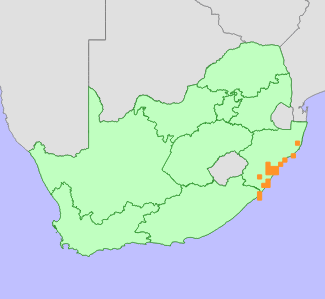| Scientific Name | Brachystelma sandersonii (Oliv.) N.E.Br. | Higher Classification | Dicotyledons | Family | APOCYNACEAE | Synonyms | Dichaelia natalensis Schltr. |
National Status | Status and Criteria | Vulnerable A4c; B1ab(i,ii,iii,iv,v)+2ab(i,ii,iii,iv,v) | Assessment Date | 2007/05/09 | Assessor(s) | L. von Staden & D. Styles | Justification | This species' coastal habitat has undergone severe and extensive transformation from the early 1800s. Small remaining habitat fragments have become invaded with dense, woody vegetation within the last 10 years which could lead to a further reduction of around 30% of available habitat within the next five to 10 years (generation length 10 years). Urban and coastal development is a severe, ongoing threat facing the only confirmed existing subpopulation. We suspect that there are up to eight remaining extant subpopulations, EOO is very uncertain, but is at the largest 6000 km². |
Distribution | Endemism | South African endemic | Provincial distribution | Eastern Cape, KwaZulu-Natal | Range | Port Shepstone to St. Lucia. |
Habitat and Ecology | Major system | Terrestrial | Major habitats | KwaZulu-Natal Sandstone Sourveld, KwaZulu-Natal Hinterland Thornveld, Pondoland-Ugu Sandstone Coastal Sourveld, KwaZulu-Natal Coastal Belt Grassland, Maputaland Wooded Grassland, Maputaland Coastal Belt | Description | Coastal grassland, 10-200 m. |
Threats | | This species is a near endemic to KwaZulu-Natal Coastal Belt grasslands (Mucina and Rutherford 2006), an Endangered vegetation type (Rouget et al. 2004) that is excessively transformed by cultivation (mainly sugarcane plantations), urban sprawl (around Durban as well as rampant coastal development elsewhere) and alien species invasions (including Chromolaena, Lantana and Solanum mauritianum) (Mucina and Rutherford 2006). About 64% of the habitat of this species had been transformed by 1996 (calculated using GIS), but this happened over a very long time period. Sugarcane has been cultivated on the KwaZulu-Natal coast since the early 1800s (D. Styles pers. comm.), which is much longer than three generations of this species, which is not thought to be very long lived (Pieter Bester pers. comm.). Only about 2000 km² of habitat remained in 1996 (calculated using GIS). However, within the last 10 years, David Styles have noted that grassland fragments have become increasingly invaded by dense woody vegetation, with some patches now classifiable as forests, due to lack of fire. Development and alien invasive species remain an ongoing threat, and it is estimated that the species could lose at least a further 30% of its remaining habitat within 5-10 years, should these trends continue. |
Population | Population trend | Decreasing |
Conservation | | Not conserved - no known localities (historical and present) are within reserves. The species had been collected in the vicinity of Kranzkloof Nature Reserve, but despite ongoing monitoring projects of threatened plants in the reserve, this species has not been located there in recent years. |
Assessment History |
Taxon assessed |
Status and Criteria |
Citation/Red List version | | Brachystelma sandersonii (Oliv.) N.E.Br. | VU A4c; B1ab(i,ii,iii,iv,v)+2ab(i,ii,iii,iv,v) | Raimondo et al. (2009) | |
Bibliography | Dyer, R.A. 1980. Brachystelma, Ceropegia and Riocreuxia. In: O.A. Leistner (ed). Flora of Southern Africa 27 Part 4:1-88. Botanical Research Institute, Pretoria.
Dyer, R.A. 1983. Ceropegia, Brachystelma and Riocreuxia in southern Africa. A.A. Balkema, Rotterdam, Netherlands.
Mucina, L. and Rutherford, M.C. (eds). 2006. The vegetation of South Africa, Lesotho and Swaziland. Strelitzia 19. South African National Biodiversity Institute, Pretoria.
Raimondo, D., von Staden, L., Foden, W., Victor, J.E., Helme, N.A., Turner, R.C., Kamundi, D.A. and Manyama, P.A. 2009. Red List of South African Plants. Strelitzia 25. South African National Biodiversity Institute, Pretoria.
Rouget, M., Reyers, B., Jonas, Z., Desmet, P., Driver, A., Maze, K., Egoh, B. and Cowling, R.M. 2004. South African National Spatial Biodiversity Assessment 2004: Technical Report. Volume 1: Terrestrial component. South African National Biodiversity Institute, Pretoria.
Styles, D. 2007. Brachystelma sandersonii - A rare and little known species from coastal KwaZulu-Natal.
|
Citation | | von Staden, L. & Styles, D. 2007. Brachystelma sandersonii (Oliv.) N.E.Br. National Assessment: Red List of South African Plants version 2024.1. Accessed on 2025/11/30 |
 Comment on this assessment Comment on this assessment
|
 © D. Jewitt  © J. Stephenson  © J. Stephenson  © J. Stephenson  © J. Stephenson  © D. Styles  © D. Styles  © D. Styles  © D. Styles  © D. Styles  © D. Styles  © D. Styles  © D. Styles  © D. Styles
Search for images of Brachystelma sandersonii on iNaturalist
|
 Comment on this assessment
Comment on this assessment


